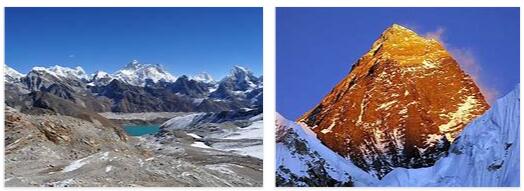The approximately 1150 km² national park is located in the midst of a magnificent mountain landscape with the highest peak in the world, Mount Everest (8850 m). In the lower areas there are numerous Sherpa settlements and monasteries. The park is a habitat for many rare animal species, such as B. the snow leopard.
Sagarmatha National Park – Mount Everest: Facts
| Official title: | Sagarmatha National Park (Mount Everest) |
| Natural monument: | Established as a national park in 1979, area of 1148 km², heights from 2845 to 8846 m (after height measurements carried out in 1999 and 2005, 8850 and 8844 m), the summit of Mt. Everest, named after Sir Georg Everest, who was trigonometric from 1823-43 Headed Surveying India; 61 Sherpa settlements as enclaves within the national park; 80% of the rainfall during the monsoon season from June to September, an average of up to 1043 mm of rainfall; the Ngozumpa glacier with 20 km the longest within the park, seven peaks over 7000 m, folding of the heights 500,000 to 800,000 years ago |
| Continent: | Asia |
| Country: | Nepal, Solu-Khumbu District |
| Location: | Border with the Tibet Autonomous Region (China), northeast of Kathmandu |
| Appointment: | 1979 |
| Meaning: | an extraordinary landscape with the highest peak in the world, Mount Everest, and a biotope for extremely rare animal species |
| Flora and fauna: | 69% of the area “wasteland” over 5000 m, 28% pasture area, about 3% of the area forested; Vegetation zone such as lower subalpine zone (3000-3600 m) with European pine, Himalayan silver fir and the juniper species Juniperus recurva, upper subalpine zone (3600-3800 m) with rhododendron species such as, among others. Rhododendron campanulatum, alpine zone over 3800 m, among others. with rhododendron anthopogon, over 4500 m grassland and dwarf shrubs, between 5500 and 6000 m and others. Rhododendron nivale; 28 species of mammals such as the snow leopard, the Hulman, the cat bear, yellow-throated marten, musk deer, larvae roller, muntjac, the Goral and Serau, which are related to the chamois, the Himalayan tahr, which is related to the sheep and goats; 152 species of birds, 6 species of amphibians and 7 species of reptiles |
In the shadow of the highest mountain on earth
The headlines in the media in May 1996 were shocking: ten dead on Mount Everest, frozen to death in agony on the highest mountain on earth. They were black days in the long history of climbing this highest eight-thousander. The discussion about the sense and nonsense of commercial expeditions to the world’s highest mountains for wealthy customers caused quite a stir.
The area south of Mount Everest, which is 8,846 meters (after height measurements in 1999 and 2005, respectively, 8,850 and 8,844 meters) was a forgotten corner until the middle of the 20th century and was only known to initiated mountaineering circles who dreamed of it, once in that dare to climb the mightiest mountain range on earth. The small hill tribe of the Sherpas, whose ancestors immigrated from Eastern Tibet via the Nangpa Pass, found a new home here about five centuries ago. The Sherpas called the newly settled region of Khumbu and the large mountain at the head of the valley Chomolungma or Sagarmatha: “King of Heaven”. They brought the Buddhist faith with them from their old homeland of Tibet, which they also created a new home in some of the monasteries that still exist today.
The Sherpa Buddhist belief expects its adherents not to kill living beings. That is why animal species such as musk deer, Himalayan tears, blue sheep, snow leopards or blood and glossy pheasants still find an almost harmless habitat. The forests in the vicinity of the monasteries in particular offer the rare high mountain animals a protective refuge. The habitat of the Yeti, the wild snowman, should extend from here to the highest snow regions. Except for large footprints in the snow, there is currently no evidence of the existence of such a creature with an ape-like appearance. Helmet-like deformed pieces of fur, kept in the temples of Pangpoche or Kumjung, turned out to be artifacts. For the Sherpas, however, the yeti is a demonic being that only shows itself to those who believe in demons.
Originally, the residents of the gray stone houses near Mount Everest were mountain farmers, ranchers and traders. With the beginning of the expeditions to the high peaks, one discovered her excellent skills as a mountain guide and high porter. The most famous among them was Sherpa Tensing Norkay. On May 29, 1953, just in time for the coronation of Queen Elizabeth II of England, he and Sir Edmund Hillary were the first people to reach the summit of Mount Everest. But the Sherpas also had to pay a high blood toll, because many stayed on the mountain. The situation finally improved with trekking tourism, because now the strong mountain dwellers were in great demand as guides and cooks for trekking groups and were able to earn a living on safer routes.
The Sagarmatha National Park was set up in 1976, as the expected tourist pressure on the sensitive mountain region was likely to cause many problems, in particular due to logging and dumping of rubbish. In this protection zone, attempts are now being made to reconcile the preservation of the original natural landscape with a traditional human settlement area. However, in order to curb the emigration from the barren area, tourism was very welcome as an additional source of income. The protected status also proved to be forward-looking, because the pollution caused by the steadily increasing tourist masses could be better controlled by means of conditions. And you can understand the longing to travel to the highest mountain on earth when you look over the tops of the firs and rhododendrons in front of the Thengpoche monastery to the eight-thousanders.
